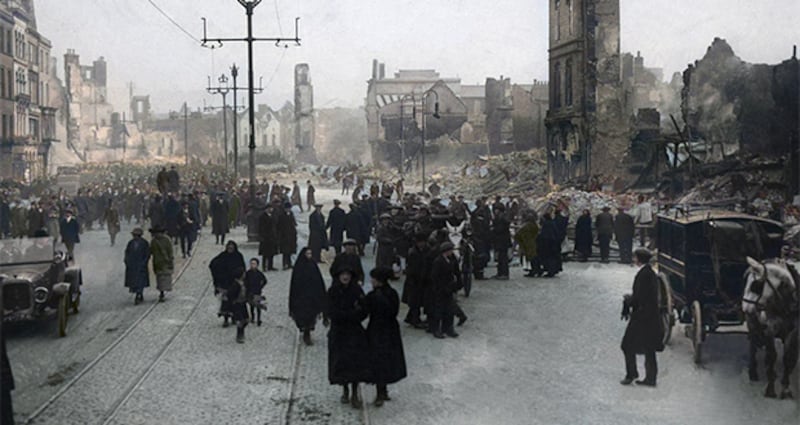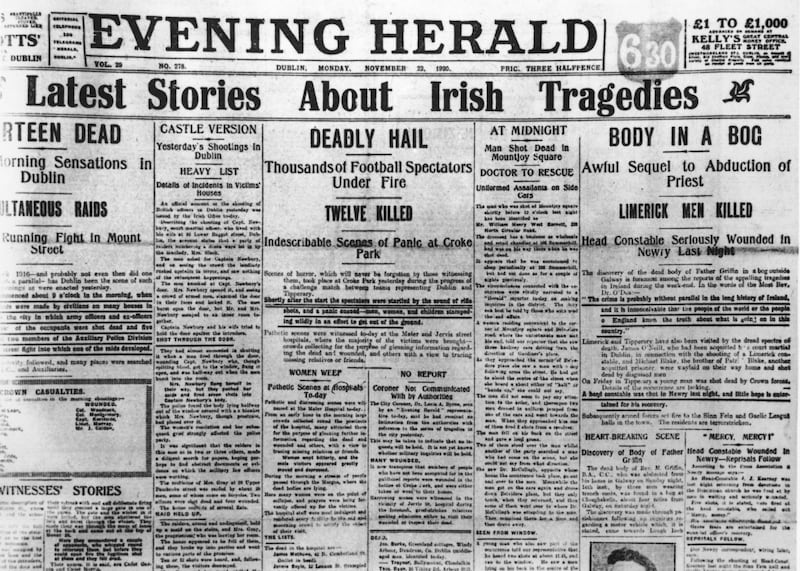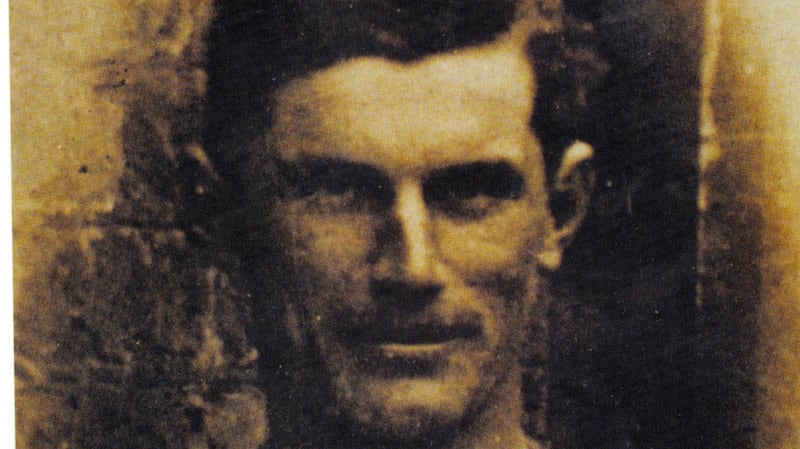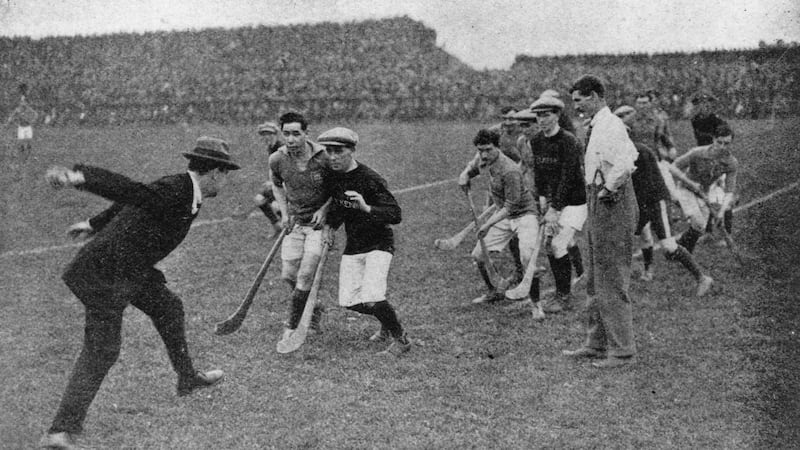With the killing of 32 people, Bloody Sunday in Dublin on November 21st, 1920, was a stark reminder of multiple War of Independence themes: the nature of violence and espionage, military and civilian casualties, the taking of significant risks, fiercely fought propaganda battles and the building and sustaining of myths about key individuals.
The fear that day was keenly felt; in the words of Michael Foley, author of The Bloodied Field, "this terror felt like it had been borne across the city by the wind". The day after the slaughter, the Evening Herald reported, "Not since Easter week 1916 – and probably not even then did one single day furnish a parallel – has Dublin been the scene of such sensational happenings as were enacted yesterday."
The killing in the morning in their flats, boarding houses and hotel rooms of 14 suspected British intelligence agents (19 men were shot; five survived) was audacious, the men forming part of a longer list – up to 35 – that the IRA and its director of intelligence Michael Collins suspected of being British agents.

The list was reduced to 15 given the enormity of the fall-out it was believed would come from killing more. But it was still a great risk.
In 1919, Collins had created two special duties units from the Dublin brigade of the IRA, which ultimately merged to form his “Squad”. Its members were charged with the task of immobilising British intelligence through brutal assassinations, but on Bloody Sunday they needed assistance from other IRA volunteers. Dick McKee, the IRA’s Dublin Brigade commander, articulated the cold logic for the mission: “If we don’t get them, they will get us.”
Jane Boyle was shot and trampled, her hand slipping from her fiancé's . . . she was buried in her wedding dress on the same day she was to be married
“Getting” them was a gruesome business. In 1953, William Stapleton, one of the Squad, described in a statement to the Bureau of Military History what happened when they arrived at 92 Lower Baggot Street to shoot Captain William Newberry. Pyjama-clad, Newberry tried to escape out the window and was shot seven times as his heavily pregnant wife watched “in a terrified and hysterical condition . . . the operation lasted about 15 minutes”. Mrs Newberry subsequently lost her baby.
That afternoon, 90 seconds of shooting by a combination of Auxiliaries, RIC and Black and Tans created another sensation. Rather than a calculated, co-ordinated reprisal, the original plan, it seems, was for an officer to enter Croke Park, where a Gaelic football match was being played between Dublin and Tipperary, stop the game and perform searches of the men in attendance.
But instead, rage, lust for revenge or just a complete breakdown in discipline took over. Military trucks reached the canal bridge overlooking Croke Park and the men jumped out and headed for the grounds, while others positioned themselves on the bridge. Some climbed over the turnstiles and began firing.
The official British report stated they were shot while trying to escape; in truth, they were tortured and murdered in reprisal for what had happened earlier that day
Michael Foley notes that 14-year-old John William Scott, who lived across the road from the grounds “was so severely wounded in the chest, questions were asked in the House of Commons the following week about whether he had been bayoneted to death.
“Victims were crushed, impaled and shot even as they left the ground. Jane Boyle was shot and trampled, her hand slipping from her fiancé’s . . . she was buried in her wedding dress on the same day she was to be married.”
Ten-year-old Jerome O’Leary from Blessington Street was shot dead as he sat on a wall behind the Canal End goal.
Fourteen were killed or mortally wounded with about 80 others injured, and later that evening two IRA prisoners were also killed, Dick McKee and Peadar Clancy, along with Conor Clune, a visitor to Dublin from Clare and simply in the wrong place at the wrong time.
The official British report stated they were shot while trying to escape; in truth, they were tortured and murdered in reprisal for what had happened earlier that day.
The Tipperary newspapers the Tipperary Star and the Nationalist used the words "Holocaust", "slaughter" and "massacre", to describe what happened in Croke Park with the Nationalist suggesting “the vicious cycle must be allowed to run its course” – a recognition, it seemed, that this was a defining but not a final tragedy.

That the killings happened in Croke Park and included the murder of Mike Hogan, a player with the Tipperary team, gave a new status to the GAA's relationship with Irish republicanism, but that was never to be straightforward given the GAA's status as a non-political organisation and the multiple allegiances and ties of its members.
The killings in the morning also created unease on the part of some within the IRA, including the young Todd Andrews, who later suggested that some of the Squad "were guilty of behaving like Black and Tans".
The wider context for Bloody Sunday was a war of independence that had intensified and in late 1920 witnessed assassination, reprisal and counter-reprisal and the high-profile execution of 18-year-old IRA volunteer Kevin Barry on November 1st.
Civilian eyewitnesses attested that the crowd were fired on without any provocation
Undoubtedly, the impact of Bloody Sunday on the British intelligence network was significant, but this was also about psychological, political and propaganda battles and ramifications of the day may ultimately have been more important in those realms than in the military or intelligence ones.
The impact Bloody Sunday made also needs to be put in the context of the rhetoric being used by senior British politicians and supposed military masterminds in late 1920. The prime minister David Lloyd George referred to the IRA as "a small murder gang", and on November 9th at a speech in London announced "we have murder by the throat".
The truth is that the maintenance of law and order had long crumbled in Ireland, and Dublin Castle struggled to put together an effective, unified security command. A failure to grasp the impact of shooting civilians continued to blight the British government’s approach to Ireland for decades, right up to the second Bloody Sunday in January 1972.
Nor was there any credible evidence to support the official claim in 1920 that unidentified gunmen in Croke Park fired the first shots; civilian eyewitnesses attested that the crowd were fired on without any provocation.
Another of the difficulties for Britain in late 1920 was losing control over public opinion, and this was not only due to the success of Sinn Féin propagandists. British correspondents and journalists, including Hugh Martin of the Daily News and JL Hammond of the Manchester Guardian were sending home objective reports of what was going on in Ireland as eyewitnesses to scenes that suggested the empire was being embarrassed by guerrilla fighters; that there patently was a war going on, despite the official denials.

Historians in recent years have been more sceptical of traditional claims about the scale of the damage inflicted by Michael Collins. Bloody Sunday undoubtedly contributed to the contention that he was “the man who won the war”. In truth, as one of his biographers Peter Hart points out, no one man planned, directed and controlled the war.
Women, including Lily Mernin, a typist in Dublin Castle, and Cumann na mBán's Evelyn Flanagan, were vital in collecting, communicating and storing information about potential targets. British historian Charles Townshend points out that the killings in the morning were not "a brilliant demonstration of pinpoint selective assassination".
Caroline Woodcock, the wife of one of the men shot who survived, recalled “the murderers had been so panic-stricken themselves and their hands so shaky that their firing had been wild in the extreme”. Not all of those shot were involved in intelligence work; some of them were, as Collins described it, “just regular officers”; they were easy targets because they had never contemplated such attacks, as prior to this no spies had been killed inside their residences.
As Anne Dolan, associate professor in Modern Irish History at Trinity College, puts it: "To admit that mistakes were made could not be countenanced by some . . . The dead were all spies because murder could not be part of the founding myth of the nation."
The short-term backlash to Bloody Sunday was not as important as the fact that neither side could afford a repeat of events on that scale
In the short term, the backlash to Bloody Sunday left the IRA reeling as a result of internment without trial and the imposition of martial law, though it was telling that the martial law introduced was a diluted version of what military chiefs wanted.
The British intelligence effort was reorganised, enhanced and put back on track. The IRA recovered too; how robust it was is debatable, but it can be asserted that overall, in the realm of “secret service”, the IRA did better and its spy network was not completely penetrated.
But neither, in terms of general intelligence, was the IRA infallible and the broader British intelligence was better than it got credit for.
But politics still mattered. At the time of Bloody Sunday, some within the republican movement were thinking in terms of length of conflict and possible channels of communication with the enemy. The short-term backlash to Bloody Sunday was not as important as the fact that neither side could afford a repeat of events on that scale. The historian Michael Hopkinson used a modern phrase – “peace process” – to describe what was emerging in late 1920 and it developed more momentum in the aftermath of Bloody Sunday.

The status of Britain’s empire, it seemed, would be better served by getting out of southern Ireland through means of a political compromise, and crucially, the IRA was enough of a broad coalition to contemplate this.
Hopkinson suggests, for example, that Collins was prepared to agree a truce in December 1920, but this did not happen for another seven months because Lloyd-George allowed himself to be convinced by the hawks who had his ear. But a beginning had been made prior to Bloody Sunday, and that willingness to work towards a truce was reinforced by the events of November 1920.
Two days before Bloody Sunday, Sinn Féin's Arthur Griffith had communicated with the British about possible terms for negotiations and CJ Phillips in the British foreign office referred to the "slender link which has been established". Progress was slow because of concerns by both sides that talk of a truce was a sign of weakness, but ultimately there would have to be a political response to a military impasse as a decisive military victory was impossible for either side.
Hopkinson suggests the importance of the 1920 Bloody Sunday was on a par with the 1972 event: a defining moment in changing British attitudes to Irish independence; its scale forcing a reassessment of the nature and long-term objectives of the war.
We now have much more of an appreciation of the long-term psychological impacts the day’s events had on the killers and the bereaved. Many carried internalised trauma for decades. As historian Paul Rouse has also noted, in reflecting last year on the unveiling of headstones by the GAA for Jerome O’Leary, Patrick O’Dowd and Michael Feery, three victims of the Croke Park slaughter who had lain in unmarked graves for 99 years, “it is essential that all of the innocent victims of the day be remembered, and in this remembrance, the raw truth of grief and irrecoverable loss”.
Diarmaid Ferriter is professor of modern Irish history at UCD and an Irish Times columnist



















